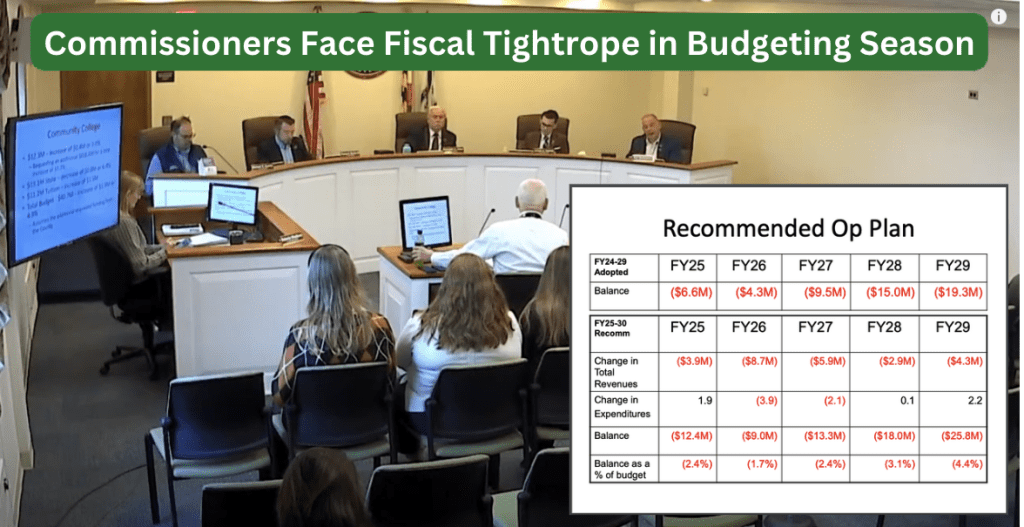Carroll County Commissioners Face Fiscal Tightrope in Budgeting Season

The Carroll County commissioners launched their budgeting season with a bang, but the fireworks weren’t celebratory. Instead, they were faced with a daunting $12.4 million deficit and the looming specter of Maryland’s Blueprint for Education, a state-level mandate that’s sending shockwaves through local budgets.
Director of Budget Tim Zaleski set the stage with a stark reminder: “The question isn’t are we doing good things, the question is how many good things can we afford to do.”
The Maryland Blueprint for Education, with its ambitious yet costly requirements, has become a focal point of concern. Carroll County expects to shoulder an additional $70 million burden over the next four years due to this legislation.
In a Carroll Republican Victory club meeting last week, Board of Education President Marsha Herbert hinted at the financial strain, suggesting that an extra $10 million may be needed this budget cycle alone to comply with Blueprint mandates.
“The state recognizes now that what they’re telling the schools to do is more than what the state plans to fund and more than what counties are planning to fund,” Zaleski noted, highlighting the tension between state mandates and local financial realities.
Carroll County is not alone in grappling with the exorbitant costs of Blueprint. Howard County’s acting superintendent recently proposed cutting several programs to bridge a $98.6 million budget gap.
Senator Justin Ready, a staunch critic of the Blueprint, sounded off on the fiscal concerns last year on X when neighboring Howard County was imploring the state to scale back Blueprint requirements to fend off their own budget deficit: “I didn’t vote for Blueprint for a number of reasons (cost concern w/out definition of success was a main one) but even for those who did – it’s clear that restructuring must take place.”
I didn’t vote for Blueprint for a number of reasons (cost concern w/out definition of success was a main one) but even for those who did – it’s clear that restructuring must take place. Must take action next session to get train back on track: https://t.co/jRW7uBLAZn #mdpolitics
— Justin Ready (@JustinReady) May 11, 2023
Commissioner Joe Viggliotti questioned whether the state’s threat to withhold 25% of Blueprint funding for non-compliance would end up costing more or less than the full implementation of the Blueprint itself.
“The threat from the state of taking 25% of the funding education that they give to the school system, is that a greater amount than what we would be required to put into Blueprint?” challenged Viggliotti.
This inquiry led to several looming question marks for the commissioners: What will the state enforce? How much funding will they snatch? Will they grant a lifeline by extending Blueprint deadlines, giving counties a fighting chance to balance their budgets?
So far, no cuts to public education have been proposed by the Board of Education or the commissioners.
Yet, Blueprint isn’t the only budgetary hurdle.
The transition of Fire and EMS services from volunteers to paid government employees has also strained the county’s finances. This transition, although deemed necessary for increased service demands, has seen the Fire and EMS budget more than double since 2020.
County Commissioners in 2020 voted unanimously to staff Fire and EMS with paid government employees after decades operating with volunteers, following earlier legislation based in 2018 by the Maryland General Assembly that allowed Carroll to establish a new department.
A total of 241 new positions are planned to staff the County Fire/Emergency Medical Services function. Momentum on the transition began in FY 23 with 98 positions approved and are in the process of being filled. An additional 59 employees are planned for FY 24 and the remaining 84 will transition in FY 25.
In a 2021 editorial to the Carroll County Times, then-president of the Westminster Fire Department Dan Plunkert expressed concerns with the transition from a volunteer model to the county taking on the employment burden, but argued that the transition is necessary to address the increased training requirements and increased calls for service in the county amidst a nationwide shortage in volunteers.
Other challenges were discussed that further added to the complexity.
Before the presentation started, Crystal Winebrenner, executive Director of Ride With Us, called in to warn the commissioners against detrimental cuts to public transit, emphasizing the community’s reliance on these services: “Less service would absolutely equal less dollars, but the cost to the community would be detrimental.”
Commissioner President Ken Kiler suggested more discussion on public library funding was necessary in light of library employees advocating for state legislation that works against county interest. “We need to talk about that. I’m not interested in paying them to go to Annapolis and fight against Carroll County.”
Commissioner Guerin inquired about the status of the artificial turf field project and whether the $2.4M in funds previously appropriated by the commissioners were in-use. Zaleski confirmed that the early stages of the artificial turf field project at Carroll Community College are scheduled to move forward this summer. Zaleski mentioned that he is expecting the college to come forward with a request to move forward with a larger sports complex project. “It’s a very expensive project. I don’t know how we can even think about it.”
County employee salaries were briefly discussed. Zaleski acknowledged that Carroll’s salaries will never match neighboring counties like Frederick or Howard, but the goal is to keep the gap to a minimum so that it still attracts talent. Commissioner Rothstein spoke of the importance of raising employee salaries to keep pace with inflation and the level of services expected of the county government. “That’s why I’m so committed to this salary increase that’s necessary just to keep pace with inflation and everything else.”
Tax increases have also been on the table for the commissioners.
According to a Maryland Muckraker report, Commissioner Rothstein suggested during a March 7th meeting that his colleagues should consider removing the supermajority requirement to raise taxes in Carroll County. This ordinance was brought forward last year by Commissioner Tom Gordon and unanimously approved by the commissioners.
The supermajority requirement mandates that 4 out of 5 commissioners must vote in favor of tax increases. It is intended to protect county residents against tax increases without careful consideration of budgetary cuts.
Rothstein’s proposal, which would allow for a simple majority to vote for tax increases, met swift resistance from Commissioners Gordon and Guerin.
“We have a public that, you know, a fair amount of them do not want to see their taxes raised” Gordon explained.
As the commissioners navigate this treacherous financial landscape, tough decisions lie ahead. The fate of essential services, employee salaries, and community investments hangs in the balance, making this budgeting season one of the most critical in Carroll County’s recent history.



